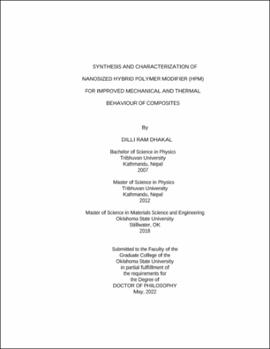| dc.contributor.advisor | Vaidyanathan, Ranji | |
| dc.contributor.author | Dhakal, Dilli Ram | |
| dc.date.accessioned | 2023-03-23T20:30:18Z | |
| dc.date.available | 2023-03-23T20:30:18Z | |
| dc.date.issued | 2022-05 | |
| dc.identifier.uri | https://hdl.handle.net/11244/337160 | |
| dc.description.abstract | Lightweight carbon fiber-reinforced polymer composites are replacing metallic components in the aerospace and automotive industries due to their improved strength-to-weight ratios and fatigue resistance. Despite their attractive properties, these composites, however, crack and delaminate due to low-velocity impact causing a drastic drop in their mechanical properties. Some of the approaches evaluated to overcome these issues include surface modification of the carbon fibers and the addition of nanoparticles such as graphene, graphene oxide etc. The addition of these nanoparticles shows improved resistance to crack propagation and reduced delamination in these composites. One carbon-based nano-additive additive, graphene oxide (GO), can achieve excellent dispersion with organic solvents in polymer matrices due to the presence of specific functional groups compatible with most composite matrix systems. However, the presence of oxygen within these functional groups makes GO moisture sensitive and results in the loss of several vital properties such as electrical conductivity and mechanical properties compared to pristine graphene. Prior research from our group has demonstrated successful grafting of GO with other molecules such as polyhedral oligomeric silsesquioxane (POSS) to optimize the thermal stability of GO. Due to the robust cage-like structure of POSS, dispersion of these hybrid nanoparticles within polymer matrices could result in an overall enhancement in the mechanical as well as thermal behavior of the composite materials. In this work, a hybrid polymer modifier (HPM) has been developed by hybridizing methacryl polyhedral oligomeric silsesquioxanes (MAPOSS) to GO via a facile redox reaction system with cerium (IV) ammonium nitrate/nitric acid (Ce(IV)/HNO3) and GO sheets’ hydroxyl groups as the redox couple, and characterized with different characterization techniques. XRF analysis showed that 10.2 mass% of silicon was added to GO due to the MAPOSS grafting. Furthermore, Raman analysis confirmed the increased structural distortion of GO induced by the incorporation of MAPOSS ((ID/IG) HPM = 1.43, (ID/IG)GO = 1.30).The dispersion of HPM was studied in thermoset resin system Epoxy and presented. In addition, the effect of HPM on polymer and carbon fiber reinforced polymer composite were studied. The result confirmed that the addition of HPM at very low wt.% can enhance the viscoelastic, mechanical, and thermal properties of composites. | |
| dc.format | application/pdf | |
| dc.language | en_US | |
| dc.rights | Copyright is held by the author who has granted the Oklahoma State University Library the non-exclusive right to share this material in its institutional repository. Contact Digital Library Services at lib-dls@okstate.edu or 405-744-9161 for the permission policy on the use, reproduction or distribution of this material. | |
| dc.title | Synthesis and characterization of nanosized hybrid polymer modifier (hpm) for improved mechanical and thermal behaviour of composites | |
| dc.contributor.committeeMember | Singh, Raman P. | |
| dc.contributor.committeeMember | Kim, Do Young | |
| dc.contributor.committeeMember | Blum, Frank D. | |
| osu.filename | Dhakal_okstate_0664D_17589.pdf | |
| osu.accesstype | Open Access | |
| dc.type.genre | Dissertation | |
| dc.type.material | Text | |
| dc.subject.keywords | carbon fiber reinforced polymer composite | |
| dc.subject.keywords | characterization | |
| dc.subject.keywords | epoxy composites | |
| dc.subject.keywords | hybrid polymer modifier | |
| dc.subject.keywords | hybridization of graphene oxide | |
| dc.subject.keywords | redox reaction | |
| thesis.degree.discipline | Materials Science and Engineering | |
| thesis.degree.grantor | Oklahoma State University | |
